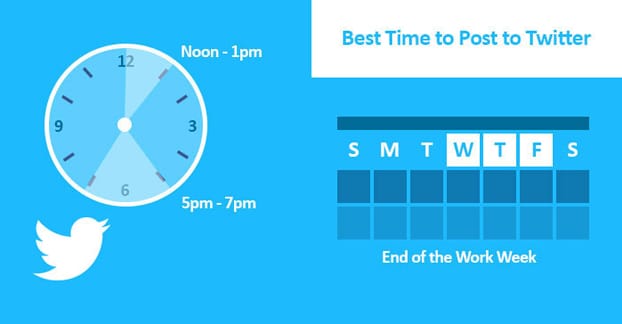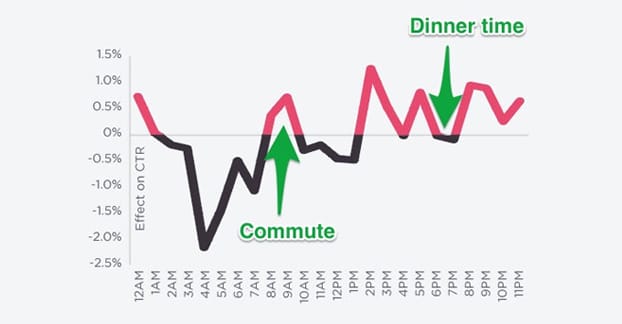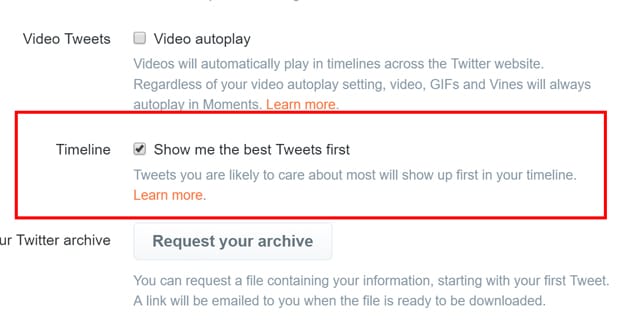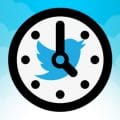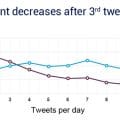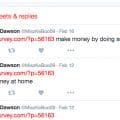Specific social media timing has become a big deal over the last few years. When reach is declining on average, people are getting more and more inundated with content, and they’re engaging less and less, it’s important to get your content in front of as many people as possible.
Timing on Twitter is especially important, because Twitter is primarily a time-based platform. When a user logs in, they get to see the posts made by the people they follow, starting with the most recent first. Depending on how fast their feed moves, they may scroll down some to see the last few hours worth of posts, or they may not. They may simply refresh to catch new posts as they are made, and ignore anything they missed.
Therefore, to reach the highest number of people, you need to be posting when they’re on and actively using the site. There’s no “post at midnight so they see it in the morning” tricks you can use, because your message will just get flooded out by all the people posting in the morning.
This is why Buffer did a big study on when and how often you should post to various social media sites. However, that study is a few years old at this point, so it’s time for some new data.
Modern Twitter Timing
The source of the data for this section of the post comes from Hubspot, which in turn comes from a variety of sources compiled by CoSchedule. The original sources include Buffer, as well as companies like Quicksprout, TrackMaven, KISSMetrics, and the Huffington Post. That’s about as authoritative as you can get, even if the data is a few times removed at this point.
Twitter is a unique social network. It’s used widely both on desktop and mobile, and it’s used both for business and for personal reasons. People check Twitter on their breaks, during commutes – ideally not while driving, but people do it anyway – and during down time. Heck, a lot of people check it when they should be working, like me, right now.
What? It’s hard to write about Twitter without checking it.
According to the data, there is a nice solid block of ideal timing throughout the week when you should post. That block happens to be from noon to 3pm on weekdays. Weekends don’t tend to be good times to post, though that may depend on your business and the kind of audience you’re trying to reach. Additionally, Wednesday has a narrow band of active hours between 5 and 6 pm.
You may be curious about what time zone I’m talking about, and to that I answer “all of them.” Specifically, you will want to be posting in those hours for the time zone of your audience. If you’re a global brand, you can expand it to be from noon Eastern to 3pm Pacific, which is 6PM on the east coast. This gives you more time to work with and more flexibility with reaching both the early risers and late visitors for your audience. On the other hand, if you’re in a narrow geographic area and you have a small, local audience, you’ll want to take the hours a little more seriously.
That said, there’s actually a lot of flexibility and variation with your Twitter timing. Some brands have audiences that don’t work normal office hours, so the normal “lunch break” sort of posting isn’t as effective. You also might find that you think you have a local audience, but you actually have a sizable following in another area, with different active hours.
I always recommend that you take the time to actually discover the active hours of your audience, specifically. Even the best advice might not work for your brand, and it’s not a flaw with the advice or with your audience; it’s simply the nature of working with people. Certain groups of people, particularly those kinds of people you accumulate in a targeted audience, will have different behaviors than the overall norm of humanity.
FollowerWonk is an app created by Moz, used for Twitter analytics. It has a lot of useful features for a Twitter account looking to grow, though many of those features are gated behind the paid version of the app. The free version, however, does include what we’re looking for; the ability to analyze your account and see when your followers are most active. The catch is, there’s a limit to the size of your account. If you have more than 25,000 followers, you won’t be able to use the free version and will have to upgrade to the “target” version. Target has a lot more features, including audience comparisons, engagement analysis, and higher follower limits, but it does cost $30 per month.
Alternatively, you can use a specialized one-time app like Tweriod. This app is completely free and it does one thing; it analyzes your audience to figure out when the best times for engagement are. It doesn’t do more, but if all you’re looking for is timing information, that’s all you really need.
Twitter’s Algorithmic Feed
Now, some time ago there was some rumbling about Twitter’s plan to implement a Facebook-like filtered feed. Some people didn’t care. Some people figured it would suck, but we would all get used to it. Some people considered it the final nail that would kill the platform entirely.
It’s true that Twitter has struggled with some bad decisions over time, trying to make their site more like Facebook and move it away from the concepts that brought people to it in the first place.
An algorithmic and filtered feed has several issues.
- With an algorithm dictating what important content to show and what to hide, some of the more high-frequency forms of microblogging disappear. Livetweeting an event, for example, becomes a thing of the past. Why livetweet when your followers only see one out of every 10 tweets? They aren’t getting the experience you want them to have.
- If a new story is slowly building and working towards critical mass, it might be squashed by an algorithm doing the filtering. National trends will always be shown, while local trends and news will take a back seat.
- There’s a potential issue with the algorithm crushing social justice movements like the Black Lives Matter movement, simply by weighting it poorly and avoiding showing it to too many people. It wouldn’t trend without exposure, and it wouldn’t get that exposure without trending.
- There’s always the possibility that sponsored voices could out-weigh organic voices. There’s a very real concern that, for example, Hillary Clinton’s media sponsorship could move to demote posts about Bernie Sanders from visibility. It’s already happening on mainstream media; with a filtered Twitter feed, it could be used as a form of political censorship.
- There is a real problem with computational algorithms being biased in many ways, up to and including overt racism. It’s never intended consequences, but many software developers have blinders on when it comes to this sort of unintended outcome, and I for one don’t trust Twitter’s developers to keep an eye out for that sort of thing.
- People already curate Twitter the way they want it. They follow people whose content they want to see, and that kind of implies that they want to see it. By having the site filter a majority of that content, it decreases usability and drives away the people who want to follow everything going on at a given time.
Twitter’s strength is in its real-time activity, not in some filtered and curated feed. There are actual content curators, or just Facebook, for that. I tend to agree with people who don’t like a filtered feed.
That said, did you know that Twitter rolled out the feed? It’s already live, and not only that, it’s the default for everyone. They launched the option all the way back in February, and now, a full month later, they’ve set the option to default. Unless you’ve changed your settings, you are currently using the filtered feed.
This is another point of annoyance for many users. Major changes like this one, they claim, should be opt-ins not opt-outs. Right now, businesses have to learn an entirely new algorithm and posting strategy, AND their audience is fragmented between filtered and unfiltered users. Timing like the advice above will work for the unfiltered feeds, but what about the filtered?
From a user perspective, the filtered feed is like an expanded version of the “while you were away” tweets list. It shows you the tweets that are most likely to be interesting to you and that occurred between the last time you logged on and this time.
Twitter claims that the people who use this new algorithmic feed tend to tweet and retweet more often, which boosts overall engagement rates. Then again, for the brands and users who get their content filtered, they no doubt see a drop, because of how few people ever get to see their tweets. This could very well be a huge detriment to small businesses, depending on how it mechanically works. We don’t have enough data yet to determine how the algorithm works specifically, what factors are considered, or how it all ranks just yet.
The idea that users won’t notice the algorithmic feed is holding water, unfortunately, which just encourages Twitter and further discourages users who like the old ways. Being forced to use the service in a way they didn’t intend is demoralizing and removes some of the reason to use it at all.
The number one biggest change to the feed, other than it being filtered, is the fact that you now have tweets showing up in a different order upon refreshing. You might read 15 tweets, see that you have 5 new ones, and refresh. You’ll then see 15 more tweets, 10 of which are ones you’ve already seen, in a different order, with the new ones mixed in.
On the plus side, it does seem that Twitter is giving the recentness of tweets a lot more weight than Facebook gives posts. The recommended or best tweets tend to rotate rapidly, and it means that timing is almost as important as it has been. In fact, if you’re posting good content, enough to attract visibility from the algorithm timing becomes less important; your tweets show up due to their value and not just due to their timing.
It remains to be seen how valuable this is to a business. I haven’t played around with it enough or measured enough data to be able to tell you whether or not I’m getting higher engagement rates. Some folks with larger audiences than mine will have to tell me.
If you don’t want to rely on the new algorithmic feed, it is still possible to disable it. Twitter has not yet made the jump to requiring it, though I’m sure that it will pull a “top stories” trick and keep turning itself back on just like Facebook.
To turn it off, go to your settings menu. On desktop, that’s clicking your icon on the top right and clicking settings. For Android, you have to tap the three vertical dots and click settings. For iOS, you need to tap the gear icon, tap the account, and tap timeline personalization.
In all cases, the option you’re looking for is “show me the best tweets first.” Uncheck the box and you’re back to the chronological feed, at least until Twitter decides to remove the option altogether.
It’s interesting to note that Twitter’s announcement of the rollout of the algorithmic feed occurred February 10th, right when their stock price hit what is a historic low for the company. The price rose for a few days, but is still trending downwards, so it’s not likely that this move will save them the way they probably hope. Of course, it’s only a month in, and only a few days of it being mandatory, so we’ll see how it all plays out.
